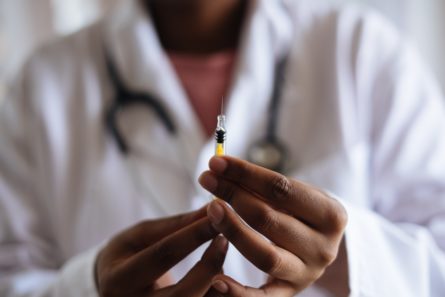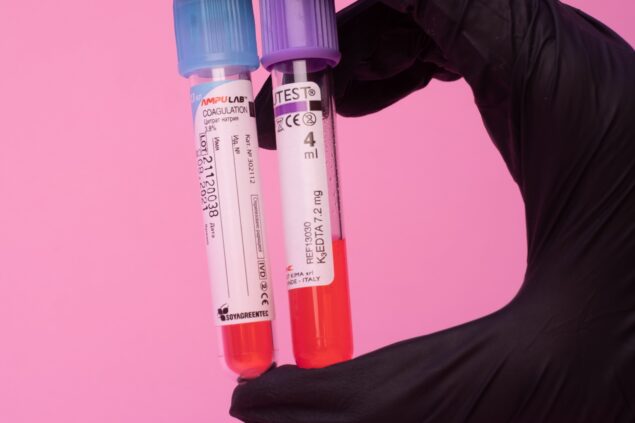Explainer Episode 20 – COVID-19 Vaccine Approval and Distribution

Joel Zinberg joins the podcast to discuss a range of COVID-19 vaccine questions. How has the development process under Operation Warp Speed compared to the normal vaccine development process? Where do the leading vaccines currently stand in terms of FDA approval? And what difficulties might arise during the distribution stage?
Transcript
Although this transcript is largely accurate, in some cases it could be incomplete or inaccurate due to inaudible passages or transcription errors.
[Music and Narration]
Introduction: Welcome to the Regulatory Transparency Project’s Fourth Branch podcast series. All expressions of opinion are those of the speaker.
Micah Wallen: Welcome to the Regulatory Transparency Project’s Explainer Podcast, which is part of RTP’s Fourth Branch podcast series. My name is Micah Wallen, and I’m the Assistant Director of Practice Groups and the Regulatory Transparency Project at The Federalist Society.
Today, I’m happy to be joined by Joel Zinberg to discuss the coronavirus vaccines and the government process. Joel is a Senior Fellow at the Competitive Enterprise Institute and is also an Associate Clinical Professor of Surgery at the Mount Sinai School of Medicine in New York, and was the former General Counsel and Senior Economist for the White House Council of Economic Advisors from 2017 to 2019.
Thank you for taking the time to join us today, and, Joel, I’ll go ahead and start right off. Where are we currently with the vaccine process?
Joel Zinberg: It’s great to be here, and I can say that we are in a really remarkable place. Vaccines for new diseases that are caused by novel viruses normally take about ten years to develop, and here we are about ten months into the pandemic and we’re on the verge of approving two new vaccines, one from the company Moderna, another from Pfizer. A third vaccine from Astra Zeneca is very close behind. Johnson & Johnson seems to be moving in the direction of getting approval soon. So we’re really in a wonderful, wonderful spot, really unimaginable when this all started out. And I think it’s just an incredible testament to the power of private markets to discover, develop, and provide lifesaving new products.
Both the Moderna and Pfizer vaccines are using a new technology called mRNA, or messenger RNA. They’ve been working on it for years, plugging away with, unfortunately, up till now, not much success. And they’ve been using — trying to make therapeutics, and then they turned their attention to vaccines a few years ago. So they were really all set up when the pandemic hit to turn their attention to this. So when the virus, the SARS-CoV-2 virus which causes COVID-19, was discovered and the genetic sequence was revealed back in January, they were in a position to move forward, and they’ve moved forward with this incredible speed. And they’ve been aided, to some extent, by the public and private partnerships both with development and with the ramp up of production, and that’s been made possible through Operation Warp Speed.
So we’re in a spot now where Pfizer is predicting they’ll have about 50 million doses by year end, and Moderna about another 20 million doses, and they’re both predicting a billion or more doses next year. So we could have — since it takes two doses to inoculate someone, we could have enough to inoculate about 35 million people by the end of the year.
Micah Wallen: Wow. And, if we indeed get one in that near of a future, and particularly if we get one by Christmas and the end of the year, that will be fantastic. What do you think the best method is to sort of set up to ensure that widespread use as fast as possible?
Joel Zinberg: Well, by the way, we should note that Moderna and Pfizer have applied in this country, but Pfizer has already gotten the go-ahead in the United Kingdom. So I think it’s very likely we’re going to get that approval here in this country.
But then, of course, it raises the issue you just mentioned: How do we make sure people use it? And this is a real problem because we know from vaccines like the flu vaccine — you know, that’s for influenza, and that’s an annual vaccine — we know that, every year, only about 45 percent of Americans actually get vaccinated.
And the surveys that have studied why it is so low indicate that people are concerned about safety. They’re worried they could get the disease from the vaccine or that there will be some bad side effects. And they’re also worried about effectiveness and the need for a vaccine. They think, “Well, they don’t work very well,” or “I never get sick,” or “The flu is not so bad; it’s not so serious that I need to be vaccinated.” And when surveys were done back in May, which was really the height of the pandemic — at least the first wave — you found that only about half of people at that point in time were willing to say they would definitely be vaccinated. And the concerns really mirrored the concerns that people had about influenza for the safety and the effectiveness of the vaccine.
And, unfortunately, since that time, there’s been an erosion in public trust because of suggestions by various people — often for political purposes, I believe — that the FDA is moving too fast, it’s cutting corners on approving these vaccines, that the manufacturers themselves are cutting corners and moving too fast on their studies looking at safety and effectiveness. And this is, sadly, being done at the highest levels. I mean, this was done, to some extent, by the Biden campaign. It was done by scientists aligned with the Biden campaign and by other political figures like New York’s Governor Andrew Cuomo, who, on multiple occasions up until very recently, has been casting doubt on the vaccine, saying he wouldn’t allow the vaccine into New York without having his own health department clear it and we should be concerned about a Trump Administration plan to approve and distribute a vaccine, and that we should wait for the Biden Administration. So I think this is going to be a potentially real problem.
We need to have these figures who have cast doubt on the vaccine in the past step forward and reassure the public that, if the FDA approves it, it’s safe and effective. And the FDA and the drug manufacturers themselves have been very vehement in their denials that there are any cutting corners here, that there’s been any kind of compromise on safety and effectiveness. They have gone out of their way to try to reassure the public. And now I think it’s time for some of these public figures to step forward and do the same thing.
And then, of course, if we can do things like — it’s been shown, at least with other vaccines, that making the vaccine free means more people will utilize it, and making it available in an easy way — for example, places of work and things like that — those are mechanisms that will encourage the voluntary uptake. And then we’re just going to have to see how many people will actually go ahead and take the vaccine.
Micah Wallen: Do you think — if it’s a lower number than we’re hoping or thinking, do you think there’s a chance that it turns into a mandatory vaccination process? And, if so, what are the legal concerns there, especially in relation to, I guess, how dire the need is or how many people start taking it just freely because it’s free?
Joel Zinberg: Well, there is precedent for mandatory vaccination. You know, we have — all 50 states have requirements for children to receive the childhood vaccines before they can attend school. You have a minority of states requiring influenza vaccination in certain settings like hospitals and health-care facilities. And there’s Supreme Court precedent going back 115 years, back to 1905 in a case called Jacobson v. Massachusetts, where the Supreme Court said that a state can exercise its police powers to protect the public health and force a vaccination even if an individual is trying to exercise their individual liberties and refuse the vaccine. So there is precedent for that.
And, even though the Jacobson Court cautioned that there would be instances where imposition of such a public health measure might be arbitrary or unreasonable and that a court could intervene in those settings, those actual settings are really pretty rare, and Jacobson remains good law to this day because several courts have invoked Jacobson when people have challenged various public health measures that have been undertaken to mitigate COVID-19. They’re still saying that this gives states very broad authority to do pretty much whatever they like in terms of infringing on constitutional rights.
And, frankly, I would argue that Jacobson is not as applicable to the current-day situation as many people think, and for two reasons: First of all, Jacobson was dealing with a smallpox epidemic. Smallpox was eradicated in 1980, but back in 1905, when the Court was deciding, smallpox was a dread disease. It had been around for thousands of years in recurrent epidemics, and smallpox would kill three out of ten people it infected. The survivors were left with scars; many of them were blinded. Smallpox affects all age groups in the population. And we’re dealing here with a very different situation with COVID. COVID is — the mortality from COVID is a whole lot closer to influenza. It’s somewhere between .2 to .6 percent of people who are infected will go on to die, not one third. It doesn’t affect all age groups in the same way that smallpox did. It clearly affects certain vulnerable populations like the elderly and people with preexisting conditions more severely. So you’re talking about a very different situation here than you had with Jacobson.
And the second reason I say it’s not — it may not be quite as applicable is that, since Jacobson, you’ve had multiple cases at the Supreme Court finding various individual liberty interests that just didn’t exist back in 1905. So, for example, we have fundamental liberty interests dealing with the rights of marriage appropriation that require courts to examine any statutes that impinge on those rights with what’s called strict scrutiny, a very high standard. You have liberty interests in your personal autonomy. That includes the rights to consent to and, more importantly, refuse medical care, even if it’s lifesaving medical care. So these are countervailing interests that courts would have to consider now that they didn’t have to consider back in 1905.
So there are a lot of reasons to say that maybe we shouldn’t have a — even though governments have and can mandate vaccinations, we should be trying to limit that sort of broad coercion and make it more narrowly tailored. And I would argue that that’s something that the private sector can probably do a lot better than the government.
Micah Wallen: That’s interesting. So, get into that a little bit more. What role do you think the private sector could play in bringing the vaccine to the general public, whether separately from government or in concert with government?
Joel Zinberg: Well, look, private entities have a lot of financial and reputational incentives to get people vaccinated. So if you’re running a business, if your employees are vaccinated, there’s going to be less illness, resulting in less absenteeism. Your vaccinated workers are less likely to, themselves, have health-care costs. They won’t infect your other workers. That will lower their health-care costs, and, in the long run, that translates into lower insurance premiums. I think businesses and private entities are going to have a competitive advantage if they can advertise that they are safety conscious and that their employees and their patrons or, in the case of medical facilities, their patients and residents don’t have — they’ve all been vaccinated, so it’s safe for you to come there.
And then, finally, these places are interested in limiting their tort liability for failing to protect workers and customers from infection. So if they can do that by requiring that their workers or residents be vaccinated, that’s a real incentive for them. So I think these are — they have all these incentives to do it, plus they’re in a position to understand the specific circumstances that their business faces. So they can tailor the mitigation measures that can include all sorts of things, including vaccines. They can try to tailor that in the most narrow and effective way possible.
And there is precedent for this. A lot of hospitals and medical facilities require their staff and, in some cases, residents to be inoculated against diseases for which we have vaccines, for infectious diseases. And, by and large, those private requirements have been upheld as legal as long as the private entities provide some measure of accommodation for people who have, say, medical contraindications to vaccination or have religious objections. So as long as they comply with those two things, the medical contraindications and religious exemptions, they, generally speaking, can do this. So I would argue that it’s better that we rely on that narrower, more focused process that private entities can bring than broad and unduly coercive government mandates.
Micah Wallen: Interesting. So what are some of the challenges you think government will face? And, also, how do you see the relationship working out between federal and local government processes even down so much to the cities? It seems like we’ve had sort of a splintered approach to the virus so far. How do you see that process rolling out with a vaccine? Do you think there will be more unity working together, or do you think we’ll still see sort of a splintered approach?
Joel Zinberg: Well, I think the immediate issue that the government faces is, how do they get enough vaccine doses quickly enough, and how do they ensure efficient distribution, and how do they ensure that it’s going to the best uses early on when we expect the vaccine supply is going to be pretty limited?
And if the government has made — part of that Operation Warp Speed that I mentioned earlier is the government has made deals with multiple manufacturers, including the ones who are seeking approval and Astra Zeneca, which we expect to come on soon, as well as the others, that they’re going to buy 100 million doses from each one. So that’s great. And, in the long run, that means we’ll have enough to inoculate, really, the entire population should we need to do so.
But the problem is, in the early going, when we only have a limited supply, how do you get that out quickly? And we’ve had the CDC, through its Advisory Committee on Immunization Practices — ACIP is what it’s called — they recently met and approved an initial vaccination plan that has to ultimately be approved by HHS — by CDC and HHS. But they suggested that they’re going to target health-care workers, both in hospitals and in long-term care facilities, as well as residents of long-term care facilities. And that mirrors what the English have said they’re going to do. And I think it’s really an excellent way to start out because health-care workers are exposed every day to people with COVID, and, in turn, they can expose other health-care workers and patients to COVID should they be infected. So you want, obviously, to vaccinate them.
And people who live in long-term care facilities are overwhelmingly people in the vulnerable populations that I referred to before. They’re the elderly and people with multiple medical conditions, so you want to get them vaccinated because they are the ones who are most likely to get severely ill and to die. So they’re making plans to do that.
That’s going to be CDC guidance, though, and this requires an interplay between the federal government and the local and state governments because, at the end of the day, it’s the local and state governments that are doing the actual health care, and they’ll be making their own regulations and their own distribution plans at their level. So we fully expect that the state and local governments are going to follow the CDC guidance and they’ll give it to these two groups first, then followed by essential workers and other adults who have high-risk medical conditions who aren’t necessarily in the long-term care facilities. But I think the long-term care facilities are key because that’s where somewhere about 40 percent of deaths have been thus far.
The good news is, of course, that we can probably cover that approximately 23 million people, the health-care workers and the long-term care facility residents, with that first round of vaccines.
Micah Wallen: That certainly sounds exciting. I’ve run out of the questions that I had planned to ask today, Joel. Thank you so much for this great information. Is there anything else you’d like to cover or leave us with today?
Joel Zinberg: Well, I think I just really want to reiterate what a remarkable achievement this has been. This is something no one predicted. There have been — well, I shouldn’t say “no one,” but very few people were predicting this, and there were a lot of skeptics that we could get a vaccine this quickly. And, as I said before, it’s just a remarkable achievement by private markets with timely aid from the government in certain settings. But it’s really an achievement of a very innovative system that we have in this country, and it’s one that we really want to preserve and not kill. And we have to make sure that you preserve the incentives to invest the time and money that is needed to create the vaccines and other lifesaving products like this.
Micah Wallen: Well, thank you so much again, Joel, for joining us today. I think it’s a great discussion on a very important issue and one that will be even more important in the months to come.
Thank you to everyone for tuning into this episode of RTP’s Explainer Podcast. Please check out our website, regproject.org, to learn more about this issue and a host of other regulatory topics.
[Music]
Conclusion: On behalf of The Federalist Society’s Regulatory Transparency Project, thanks for tuning in to the Fourth Branch podcast. To catch every new episode when it’s released, you can subscribe on Apple Podcasts, Google Play, and Spreaker. For the latest from RTP, please visit our website at www.regproject.org.
[Music]
This has been a FedSoc audio production.

The Federalist Society and Regulatory Transparency Project take no position on particular legal or public policy matters. All expressions of opinion are those of the speaker(s). To join the debate, please email us at [email protected].







